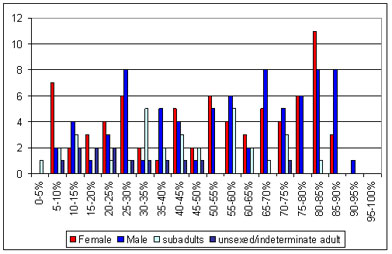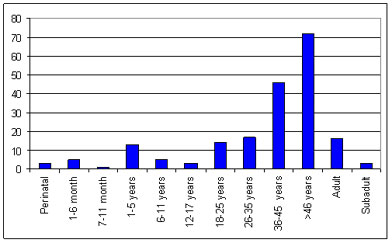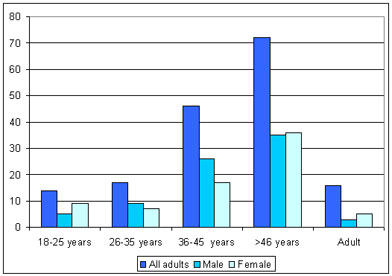Chelsea Old Church (post-medieval) cemetery summary
During the Second World War Chelsea Old church was completely destroyed by bombings. The church was rebuilt to its former glory in the 1950s.
In the 1960s further building work took place, which caused part of the 18-19th century churchyard to be exhumed and reburied (Russett and Pocock 2004).
In 2000 further excavations were carried out by Museum of London Archaeological Services in advance of further development. A total of 290 skeletons were exhumed of which 198 individuals were analysed. Two burial vaults and two brick lined graves were uncovered but the majority were earth cut stacked graves. The coffins were mainly wooden, some with lead lining.
A number of coffin plates attached to the burials, provided identification or partial identification of 25 individuals. Based on biographical data and location, the cemetery was considered to consist of mainly high status individuals who lived in Chelsea during the 18-19th century, with the coffin plates dating the cemetery between 1712 and 1842 (Cowie et al. 2008).
Preservation
The site was well preserved with a good overall completeness. The Sub adults were the least complete (fig.1), and based on the biographical data also believed to be underrepresented in the skeletal assemblage (Cowie et al. 2008).
| Preservation | N= | % |
|---|---|---|
| Good | 176 | 88.9 |
| Medium | 18 | 9.1 |
| Poor | 4 | 2 |
Table 1 Skeletal preservation
 Figure 1: Skeletal Completeness (N=198)
Figure 1: Skeletal Completeness (N=198)
Demography
A total of 198 skeletons were included in the final analysis consisting of 168 adults (74 females, 78 males and 16 unsexed) and 33 sub adults (fig 2 & 3).
Two female individuals [161] and [234] were uncovered with foetuses in the womb area; one foetus was only 20-22 weeks old [1611] whilst the other was 38-40 weeks [2341]. Child mortality in the population was high amongst the youngest with 73% (22/30) of the aged sub adults dying before the age of 5 years (Cowie et al 2008).
Individuals with biographical data consisted of seven females, 14 males, two unsexed adults and two female sub adults making up seven family groupings (Cowie et al. 2008).
The sex profile of the adults revealed that a majority lived into old age, which was also reflected in the biographical data, where 15 of the 25 individuals died over the age of 60 (Cowie et al 2008). The ratio of males to females in the younger age category was 1:1.8, which is perhaps a reflection of how perilous child birth was.
 Figure 2: Age distribution (N=198)
Figure 2: Age distribution (N=198)
| Age | N= | % |
|---|---|---|
| Perinatal | 3 | 1.52 |
| 1-6 month | 5 | 2.53 |
| 7-11 month | 1 | 0.51 |
| 1-5 years | 13 | 6.57 |
| 6-11 years | 5 | 2.53 |
| 12-17 years | 3 | 1.52 |
| 18-25 years | 14 | 7.07 |
| 26-35 years | 17 | 8.59 |
| 36-45 years | 46 | 23.23 |
| >46 years | 72 | 36.36 |
| Adult | 16 | 8.08 |
| Sub adult | 3 | 1.52 |
Table 2 Age distribution (N=198)
 Figure 3 Male and female distribution by age in the adult population (N=165)
Figure 3 Male and female distribution by age in the adult population (N=165)
| All adults | % | Male | % | Female | % | |
|---|---|---|---|---|---|---|
| 18-25 years | 14 | 8.5 | 5 | 6.4 | 9 | 12.2 |
| 26-35 years | 17 | 10.3 | 9 | 11.5 | 7 | 9.5 |
| 36-45 years | 46 | 27.9 | 26 | 33.3 | 17 | 23.0 |
| >46 years | 72 | 43.6 | 35 | 44.9 | 36 | 48.6 |
| Uassigned Adults | 16 | 9.7 | 3 | 3.8 | 5 | 6.8 |
| Total | 165 | 78 | 74 |
Table 3 Male and female distribution by age in the adult population
Stature
| Sex | Avg_stat | SD | VAR | MIN | MAX | N |
|---|---|---|---|---|---|---|
| Female | 163.4 | 4.2 | 17.6 | 155.9 | 172.8 | 36 |
| Male | 168.4 | 5.8 | 33.5 | 156.6 | 178 | 37 |
| Unsexed | 167.9 | 6.9 | 47.7 | 161.1 | 177.1 | 4 |
Table 4 Stature estimation from femoral length
Pathology
The Chelsea population reflect a typical post medieval disease pattern. Conditions often caused by excess in the diet, such as DISH and Gout were noted. Interestingly, only a single very tentative case of veneral syphilis was found. Trauma appeared to be commonplace in particular amongst the males, who had almost twice the rate of fractures than the females. Amongst the sub adults, metabolic disorders were the most frequent pathology.
Conditions such as residual rickets and osteomalacia in adults were likewise seen at a relatively high rate, suggesting that metabolic disorders were rife through the generations. The most common disease of the elderly was osteoarthritis in both males and females, whilst osteoporosis was seen mainly in the female population.
Chelsea Old Church pathology (Word 134kb)
Vertebral pathology
Table 5 provides a crude distribution of vertebral pathologies in the adult population. These were almost consistently higher in the males, particularly Schmorl’s nodes.
| All adults | Male | Female | |||||||
|---|---|---|---|---|---|---|---|---|---|
| N | n | % | N | n | % | N | n | % | |
| Osteoarthritis | 139 | 40 | 28.8 | 70 | 22 | 31.4 | 62 | 14 | 22.6 |
| Osteophytosis | 139 | 94 | 67.6 | 70 | 50 | 71.4 | 62 | 41 | 66.1 |
| IVD | 139 | 51 | 36.7 | 70 | 26 | 37.1 | 62 | 23 | 37.1 |
| Schmorl's nodes | 139 | 60 | 43.2 | 70 | 39 | 55.7 | 62 | 18 | 29 |
| Fusion | 139 | 9 | 6.5 | 70 | 5 | 7.1 | 62 | 4 | 6.5 |
Table 5 Distribution of vertebral pathology by sex in adults with one or more vertebrae present
Dental pathology
Dental health of the Chelsea population proved typical for a post medieval population. The rate of ante mortem tooth loss and caries was high (Cowie et.al 2008). The figures shown on Table 6 indicated that females suffered a higher rate of caries and periapical lesions than males. Enamel hypoplastic defects were not uncommon and in some individuals possible lines of arrested growth were seen on the roots of the dentition.
| Caries | Calculus | Hypoplasia | Periodontitis | Periapical lesions | |||||||||||
|---|---|---|---|---|---|---|---|---|---|---|---|---|---|---|---|
| N | n | % | N | n | % | N | n | % | N | n | % | N | n | % | |
| Male | 48 | 25 | 52.1 | 48 | 45 | 93.8 | 48 | 29 | 60.4 | 48 | 37 | 77.1 | 54 | 11 | 20.4 |
| Female | 41 | 29 | 70.7 | 41 | 39 | 95.1 | 41 | 23 | 56.1 | 40 | 27 | 67.5 | 45 | 14 | 31.1 |
| All adults | 92 | 57 | 62 | 92 | 86 | 93.5 | 92 | 54 | 58.7 | 91 | 66 | 72.5 | 104 | 26 | 25 |
| Sub adults | 21 | 5 | 23.8 | 21 | 6 | 28.6 | 21 | 5 | 23.8 | 12 | 1 | 8.3 | 15 | 0 | 0 |
Table 6 Distribution of dental pathology by sex in adults with one or more vertebrae present
Discussion
The Chelsea Old church individuals represent a population who lived in the outskirts and more rural areas of London during the 18-19th century, offering a unique opportunity to compare the effects of living in the country with those living in the population dense urban areas. The cemetery was considered to hold mainly high status individuals and thereby offer an excellent comparative dataset to less affluent cemeteries such as St Brides Lower churchyard and Redcross Way.
Named individuals are only rarely maintained as an archival collection and considered invaluable in enhancing osteological research methods.
Site location
Chelsea Old Church, 2-4 Old Church Street, Chelsea, SW3
Sitecode: OCU00
Recorded by: Bekvalac J and Kausmally T
Last updated: 20 February 2009







